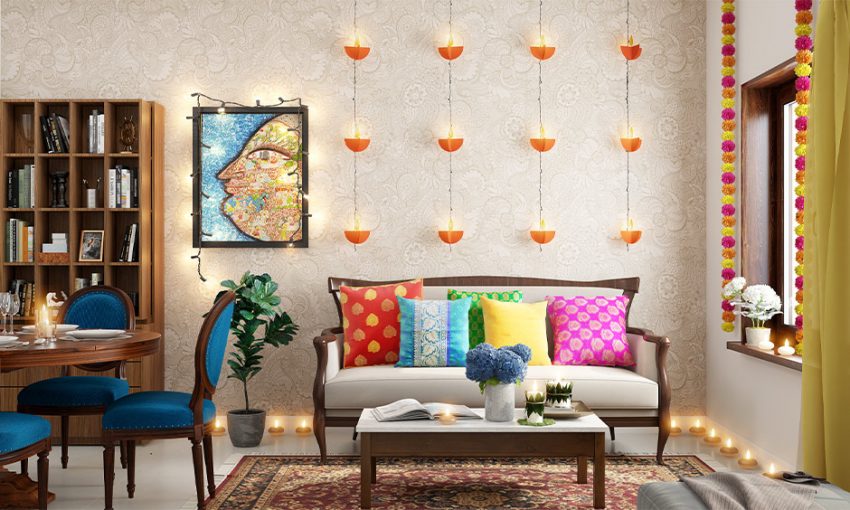Home Decorating Tips For the DIYer in You

Home stagers are experts at highlighting your home’s positives and hiding its negatives. They can make it attractive to anyone. We spoke to several professionals across the country for their tips on how to update the rooms of your home without going over budget.
10 DIY Home Decorating Ideas
1. Set the tone at the front door
Paint the front door in a vibrant, fun color. Lara Allen Brett, an interior designer in New Jersey, says that red is considered a lucky colour by many cultures. In early America, a red door was a welcome sign for weary travelers. On churches, it is a symbol of safety.
According to Christopher Breining, a San Francisco-based stage designer, orange and yellow are also gaining popularity. Both colors are associated warmth and joy. A screen door that is outdated should be thrown out. Replace it with a full-length storm door that can be replaced with a screened panel.
2. Paint Wall Colors Neutral and Light
Keep colors neutral, like beige and gray, on the first level, where flow is key. Breining says that you should minimize abrupt transitions. Neutral walls allow you the most flexibility in decorating, as you can easily change your accessories.
If you have two rooms that are close together, you can make them appear larger by painting them in the same neutral colour. Allen-Brett suggests that you can use a paint strip to change the color of a room by moving up or down two shades.
3. Living Room: Your sofa should talk to your chair
Imagine a hotel lobby with furniture arranged into groups that encourage conversation. Aim for the same balance and intimacy when you arrange furniture in your living area.
Michelle Lynne is a Dallas-based stylist who says that a conversation area with a U shape, where a couch and two chairs are placed at either end of the coffeetable, or a H-shape with a couch directly opposite two chairs with the coffeetable in the middle would be ideal.
Avoid pushing all furniture up against the wall. She says that people do this because they believe it will make the room appear larger, but actually, moving the furniture away from walls makes the space feel bigger.
4. Let the sun shine in your kitchen
Lynne says that if you have heavy, outdated drapes on your windows, it’s better to leave them bare than cover them with ugly ones. Window dressings are meant to be both functional and elegant. Think sheers with full-length panels.
If you have a room that gets a lot sun, choose light colors. They won’t fade. Cotton, linen and silk blends are the most popular lightweight fabrics because they hang well.
5. Install at least one mirror in every room
Breining says that mirrors can brighten up a room by reflecting light. Placing a mirror in the wrong place can be as bad as having none at all.
Mirrors should be placed perpendicularly to windows and not directly opposite. If you hang a mirror opposite a window, it can bounce light back through the window.
6. You can scale up your artwork to fit the wall
Breining says that hanging tiny little artwork too high up on the wall is a ridiculous look. The middle of the picture should be at eye-level. If one person is tall and the other short, then average their heights.
Take into consideration the scale of your wall. For a large space, you can go for one piece that is oversize or you can group smaller pieces in a gallery style. If you choose the latter option, do not space your pictures too widely apart. 2 to 4 inch spacing is usually the best.
7. Layer Your Lighting
Each room should have at least three types of lighting. Ambient, which gives a general illumination, is usually provided by ceiling fixtures. Task, often located over a kitchen or reading nook, and accent are more decorative and highlight, for example, artwork.
You should use at least 3 watts per square foot for a living area. One visual trick Breining swears by: using uplights. He says that placing a canister light or torchiere at the corner of a room will make the ceiling glow, and the room appear larger.
8. Anchor Rugs under Furniture Feet
Breining says that you should follow these simple rules when choosing an area rug. “In a sitting room, the rug should be large enough to accommodate all four legs from the sofa and chairs. It should also define the seating space,” he says. He adds that at the very least the two front legs of a sofa and chair should rest on the rug.
To accommodate seating in a living room with less-than-generous proportions, an 8-by-10 or 9-by-12 foot rug is usually required. If you choose a rug that is too small, it will make the room look out of proportion.
9. Hire a Professional to Declutter
As you get older, you will see less and less of the mess. You may need to get a new pair of eyes. Hire an organizer to work on your bookshelves or closets.
Breining recommends reducing the amount of items on your shelves by 50%. Mix horizontal stacks of book among vertical rows, and add decorative items, such as bowls and vases.
10. You can raise the ceiling by using visual tricks
Paint your low ceilings white to create a more spacious feeling. Allen-Brett suggests hanging curtains higher than windows to fool your eye into believing the room is bigger. The standard curtain panels are 84 or 96-inches long, so you can hang them 3 inches higher than the window casing without the curtains being too short.
You’ll need to order custom drapes if you want them to be hung higher. Do you love patterned panels or curtains? Vertical stripes will visually lengthen your walls. A large mirror leaning against a wall will also help make the room appear taller.
11. Old finishes can be given the Cinderella treatment
Have outdated fixtures? Refinish them using spray paint or inexpensive kits. Breining says that a 1980s brass lamp can be given a new lease of life by spray painting it in hammered bronze or satin nickel.
White paint and new hardware can be used to update even old kitchen cabinets. If you thought Formica counters were hopeless, then think again. Breining swears that Rust-Oleum countertop transformations are a DIY counter coating product that simulates stone. It can make even the most ugly 1970s counters look new.
It’s time to replace the cracked, mismatched and broken switch plates and outlet covers with new ones that match. Lynne says: “Nothing brings down a newly renovated space more than a dingy switch plate in almond color.”




Leave a Reply